How to Grow a Jacaranda Tree: Expert Advice for Spectacular Results
- April 19, 2024
- 1 comment
The Jacaranda tree is renowned for its breathtakingly beautiful purple-blue blossoms and fern-like foliage. A staple in tropical and subtropical landscapes, this tree not only enhances the visual appeal of its surroundings but also provides ample shade with its wide, spreading canopy.
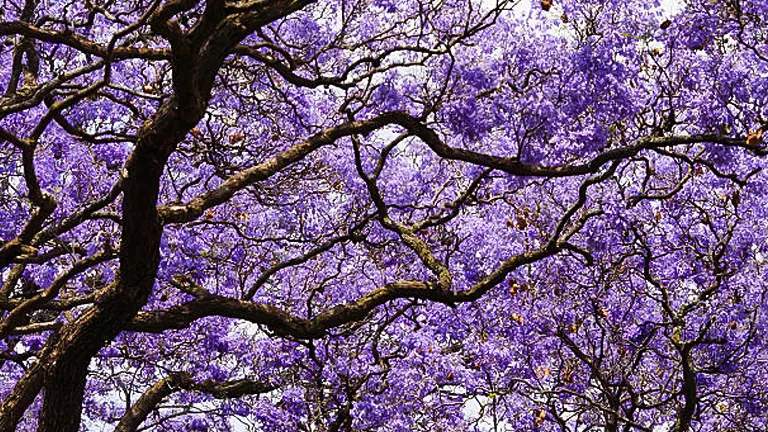
In this guide, you’ll learn how to successfully grow a Jacaranda tree, starting from the basic soil requirements, to planting and long-term care, ensuring that your tree remains healthy and vibrant for years to come.
Table of Contents
- Understanding Your Jacaranda Tree
- Planting and Initial Care of Your Jacaranda Tree
- Ongoing Care for Your Jacaranda Tree
- Troubleshooting Common Issues with Jacaranda Trees
- Long-Term Care for Your Jacaranda Tree
- Conclusion
- FAQs
Understanding Your Jacaranda Tree
Botanical Profile
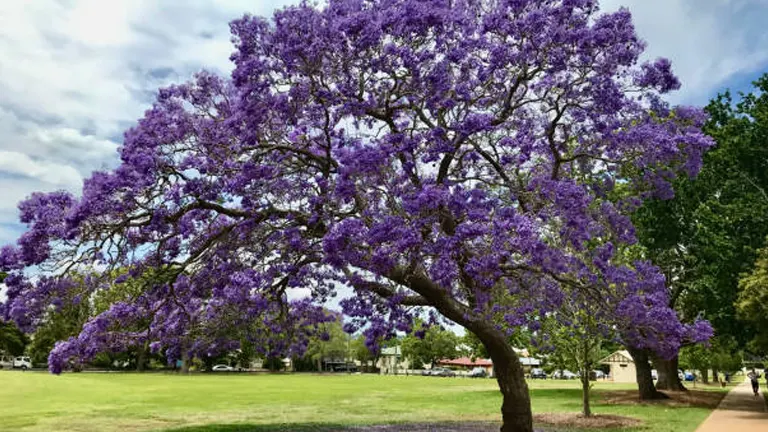
Jacaranda mimosifolia, commonly referred to simply as ‘Jacaranda,’ is renowned for its stunning flower displays and rapid growth. Understanding its characteristics is essential for successful cultivation:
- Height and Spread: At maturity, Jacarandas can reach heights of 40 to 50 feet with a canopy spread of 25 to 30 feet. Their open, spreading branches create a rounded shape that provides ample shade.
- Leaves and Blooms: The tree’s bipinnate leaves are fern-like, up to 20 inches long, and turn yellow in the fall. In spring and early summer, it produces clusters of trumpet-shaped, lavender-blue flowers, which are its most defining feature.
- Growth Pattern: Jacarandas are fast growers in their early years. They prefer full sun and can tolerate a variety of soil types as long as they are well-draining. The tree is deciduous or semi-evergreen, depending on the climate.
Optimal Environmental Conditions
- Soil: They thrive best in sandy, well-drained soils with a slightly acidic to neutral pH level. Good soil preparation with organic matter can enhance drainage and fertility.
- Climate: Ideal in USDA zones 9b to 11. Jacarandas need a frost-free environment with moderate winters and warm summers.
- Sunlight: Full sun is essential for optimal growth and blooming. The tree should receive at least six hours of direct sunlight daily.
- Watering Needs: Regular watering is crucial, especially during the hot season. However, once established, Jacarandas are relatively drought-tolerant.
Planting and Initial Care of Your Jacaranda Tree
Step 1: Choosing the Right Time and Place
Plant your Jacaranda tree during the cooler parts of the year, typically in early spring or late fall. This timing helps the tree establish itself without the stress of midsummer heat. The location should offer full sun exposure, which is crucial for the tree to thrive and bloom prolifically.
- Select a spot receiving at least six hours of direct sunlight daily.
- Ensure ample room for the tree to grow, considering its mature height and spread of up to 50 feet.
- Jacarandas prefer well-draining soil. A sandy loam soil enriched with organic compost is ideal for facilitating good drainage and nutrient absorption.
Step 2: Preparing the Planting Site
Prepare the site by deeply loosening the soil at least twice as wide as the tree’s root ball and equally deep. This extensive preparation is key to encouraging the roots to spread easily.
- Mix in well-rotted organic matter or a balanced compost into the excavated soil to increase fertility and improve soil structure.
- Ensure the soil pH is slightly acidic to neutral (pH 6-7). Adjust the pH if necessary using soil amendments.
Step 3: Planting the Tree
Remove the Jacaranda tree from its nursery container, being careful to keep the root ball intact. If the roots are densely packed, gently tease them apart to encourage them to grow outward.
- Place the tree in the center of the prepared hole. The top of the root ball should be level with the ground surface. Backfill the hole with the amended soil, gently firming it down as you go to eliminate air pockets.
- Water the tree thoroughly after planting to settle the soil around the roots and help reduce transplant shock. This initial deep watering is crucial for establishing initial moisture levels for the roots.
Step 4: Mulching and Additional Soil Care
Apply a 2-3 inch layer of organic mulch around the base of the tree but not touching the trunk. This will help maintain soil moisture, suppress weeds, and regulate soil temperature.
- Use bark, wood chips, or leaf mulch to effectively retain water and prevent weed growth.
- Keep the mulch a few inches away from the trunk to prevent moisture retention against the bark, which can cause rot.
Step 5: Establishing a Watering Routine
Establish a watering schedule that maintains moist but not waterlogged soil. Over the first few months, deep watering should be done weekly.
- Check soil moisture regularly by feeling the soil under the mulch; it should be moist but not soggy.
- Reduce watering frequency as the tree establishes and begins new growth, especially heading into the winter.
Step 6: Staking the Tree (if necessary)
If your location is particularly windy, consider staking the tree during its first year to ensure stability.
- Place stakes on opposite sides of the tree, tying the tree loosely with tree ties to allow some movement. Movement helps strengthen the tree trunk.
- Keep the stakes in place for at least the first growing season or until the tree is stable enough to withstand wind on its own.
Ongoing Care for Your Jacaranda Tree
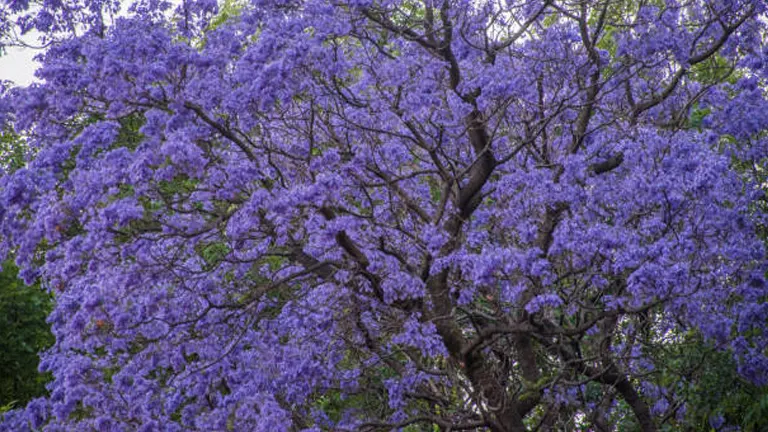
After your Jacaranda tree is planted, establishing a regimen of care that encourages robust health and vibrant blooms is crucial. This section provides a narrative guide on maintaining your tree through watering, nutrition, and pruning practices.
Consistent Watering Practices
Water management is critical for young Jacaranda trees, which require consistent moisture to support their rapid initial growth. Establishing a deep and extensive root system is crucial during this early stage, setting the foundation for the tree’s future health and stability.
- Initial Watering: In the tree’s first growing season, water deeply twice a week to maintain moist soil conditions. Adjust the frequency based on rainfall and temperature, reducing watering in wet and cool conditions to prevent soggy soil.
- Mature Tree Watering: As the Jacaranda matures, its need for water decreases. Mature trees require watering once every week or two, depending on weather conditions, with deep watering recommended to encourage root growth deep below the surface, which supports the tree’s health during dry periods.
Nutritional Requirements and Fertilization
Fertilization boosts the tree’s growth and enhances its flowering potential. The right type and amount of fertilizer depend on the soil’s inherent fertility and the tree’s developmental stage.
- Spring Feeding: Apply a balanced, slow-release fertilizer early in the spring as the tree comes out of dormancy. This provides essential nutrients for leaf and branch development ahead of the blooming period.
- Late Summer Boost: A second application of fertilizer in late summer can help strengthen the tree ahead of the winter, fortifying its reserves and aiding in root development.
- Adjusting Fertilization: Observe the tree’s response to fertilizing, particularly how it affects growth and flowering. Excessive nitrogen can promote leaf growth at the expense of flowers. If the tree appears overly lush but with few flowers, reduce the nitrogen level in your fertilization regimen.
Pruning for Shape and Health
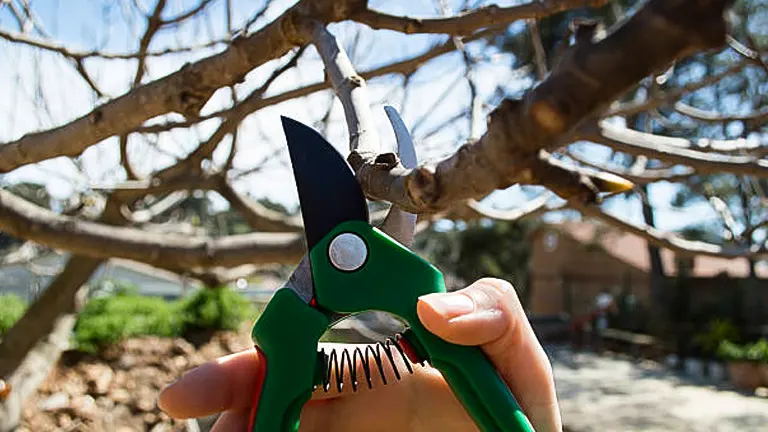
Pruning not only shapes the tree but also encourages healthy growth and abundant flowering. It should be timed and executed properly to avoid stressing the tree.
- Winter Pruning: The dormant season is the ideal time for major pruning to shape the tree and remove any unwanted branches. This minimizes stress and sap loss, which can attract pests.
- Selective Thinning: Remove interior branches that cross or crowd each other to improve sunlight penetration and air circulation throughout the canopy, which is vital for reducing disease risk and promoting bloom production.
- Deadwood and Damage Removal: Regularly remove dead or damaged branches to keep the tree healthy and well-groomed. This also helps to prevent pest invasions and fungal infections.
Monitoring and Managing Pests and Diseases
Regular inspections can catch early signs of pest infestations or disease, which is easier to manage if detected early.
- Pest Inspections: Look for aphids, borers, and scale insects, which are attracted to stressed or newly planted trees. Symptoms include sticky leaves, visible insects, and stunted growth.
- Disease Prevention: Fungal diseases are less common but can be devastating. Ensure good air flow around the tree and avoid wetting the leaves when watering to prevent fungal spores from taking hold.
- Eco-Friendly Interventions: Use insecticidal soap and neem oil for managing pests and mild fungicides for early signs of fungal diseases. These treatments are effective and have minimal environmental impact.
Troubleshooting Common Issues with Jacaranda Trees

Even with the best care, Jacaranda trees can encounter health problems that manifest through their leaves, branches, and blooms. Understanding how to identify and resolve common issues will keep your tree thriving in adverse conditions.
Dealing with Leaf Drop and Yellowing Leaves
Leaf issues are often the first sign of health problems in Jacaranda trees. Yellowing leaves can result from a variety of causes including nutritional deficiencies, water stress, or disease.
- Nutritional Deficiencies: Iron and magnesium deficiencies are common in Jacarandas, especially in alkaline soils. Symptoms include yellow leaves with green veins. Treatment involves applying chelated iron or magnesium sulfate to the soil.
- Water Stress: Both underwatering and overwatering can cause leaf yellowing and drop. Ensure the tree is watered deeply but infrequently, and adjust based on weather conditions—more frequent watering in dry, hot periods and less during cool, moist conditions.
- Disease Influence: If yellowing is accompanied by other signs like spotting or mildew, it may be a disease. Improving air circulation and reducing leaf wetness can help prevent many fungal diseases.
Preventing and Managing Pest Infestations
Pests can be detrimental to Jacaranda trees, stunting growth and diminishing the tree’s aesthetic value. Common pests include aphids, which leave a sticky residue on leaves, and borers, which can damage the tree from the inside.
- Regular Monitoring: Check your tree regularly for signs of pests—look for visible bugs, holes in the wood, or a honeydew substance on leaves.
- Natural Predators: Encourage beneficial insects such as ladybugs and lacewings, which prey on aphids and other small pests.
- Appropriate Treatments: Use insecticidal soaps or horticultural oils which are effective against a range of pests and are safer for the tree and the environment compared to chemical pesticides.
Fighting Fungal Diseases
Fungal diseases can affect the tree’s health and are often facilitated by humid conditions and poor air circulation around the tree.
- Common Fungal Issues: Watch out for signs of root rot or powdery mildew, which typically present as discolored, wilting leaves or a white, powdery residue on the leaves.
- Improving Conditions: Ensure that your tree is planted in well-draining soil and that mulch is not piled against the trunk to prevent excess moisture around the base.
- Fungicide Use: For severe infections, apply a fungicide specifically designed for the type of fungus affecting your tree. Always follow the application instructions carefully to avoid damaging the tree.
Addressing Lack of Flowering
A Jacaranda’s stunning blue flowers are its most celebrated feature, but sometimes trees fail to flower satisfactorily. This can be due to several factors.
- Age Factor: Young Jacaranda trees might not flower until they are several years old. Trees less than 2-3 years old often focus their energy on growth rather than blooming.
- Light Conditions: Insufficient sunlight is a common reason for poor flowering. Trees need full sun to produce the energy required for blooming.
- Pruning Timing: If Jacarandas are pruned at the wrong time, it can severely impact their blooming cycle. Prune right after the blooming season to avoid cutting off next year’s buds.
Long-Term Care for Your Jacaranda Tree
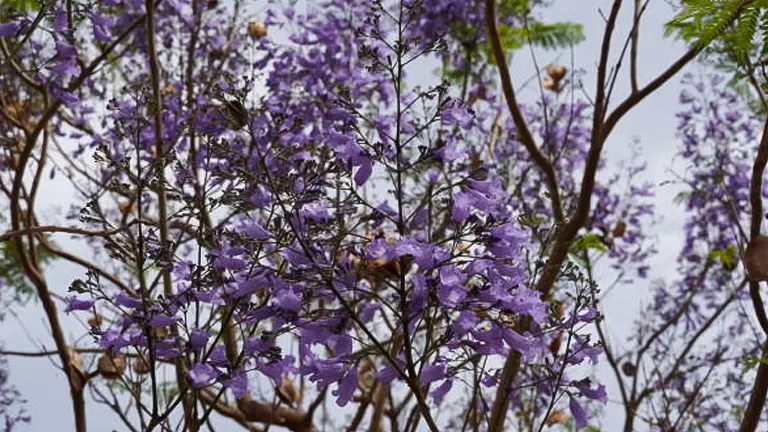
Maintaining a Jacaranda tree is a deeply rewarding endeavor that not only enhances the aesthetic value of your garden but also contributes to local ecology by providing shade and habitat. As we conclude this guide, we’ll recap essential care tips and offer some final thoughts to help ensure your tree remains a vibrant and healthy centerpiece in your landscape for many years.
Holistic Approach to Care
Regular and attentive care throughout the year is crucial for the well-being of your Jacaranda tree. Watering should be adjusted according to the seasons, with the soil kept moist, especially during dry spells. As the tree matures, less frequent but deeper watering will encourage stronger root growth, which is essential for overall health and stability.
Fertilization is most critical during the growth phases of early spring and again in mid-summer to prepare the tree for the cooler months. A balanced, slow-release fertilizer will nourish the tree with the right nutrients needed to enhance its bloom potential and leaf vigor.
Pruning is best performed in late winter or early spring to maintain the desired shape and health of the tree. It involves removing dead or overgrown branches, which helps prevent disease and promotes better air circulation and sunlight exposure across the tree. This not only supports the tree’s growth but also increases flower production.
Integration into the Landscape
Jacaranda trees make fantastic focal points in large garden spaces due to their size and the beautiful flower canopy they provide. Planting companion plants that thrive in the dappled light under the Jacaranda can enhance ground cover and biodiversity. Suitable companions include impatiens and ferns, which add texture and color contrast to the area directly beneath the tree’s canopy.
Adapting to Seasonal Changes
It’s important to modify your care routine to protect the tree from seasonal stressors:
- In cold climates, apply a thick layer of mulch before winter to protect the roots from freezing temperatures.
- In peak summer, ensure the tree has sufficient water, especially if there are prolonged dry periods. Mulching also helps retain soil moisture and keeps the roots cool.
Related Post
- How to Fertilize a Mango Tree Effectively: Tips and Tricks for Healthy Growth
- How to Fertilize Apple Trees: Essential Tips for a Bountiful Harvest
- How to Fertilize Lemon Trees: Secrets for Thriving Citrus
- How to Fertilize Avocado Tree: A Step-by-Step Guide for Lush Growth
- How to Fertilize Bougainvillea: A Complete Guide for Stunning Blooms
Conclusion
The joy of cultivating a Jacaranda tree lies in the journey from sapling to mature tree. Patience is required, especially in the early years when growth is more about establishing roots than producing flowers. Enjoy the process and engage regularly with the care of your tree—monitor its health, adjust care strategies as needed, and always be proactive in managing pests and diseases.
Your efforts will be rewarded with a stunning display of purple blooms each spring, creating a spectacular natural spectacle in your garden. As your Jacaranda tree grows, it will become more than just a plant; it will be a living part of your home’s landscape, contributing to its beauty and the environment around it. By following these guidelines, your Jacaranda will thrive, providing joy and natural beauty for many years to come.
FAQs
- What is the best time of year to plant a Jacaranda tree?
The optimal planting time for a Jacaranda tree is in the cooler months of early spring or during autumn. This timing allows the tree’s roots to establish in the mild weather, avoiding the extreme stresses of winter frost and summer heat. - How much sun does a Jacaranda tree need?
Jacaranda trees require full sun to thrive and produce the best blooms. Ideally, they should receive at least 6 hours of direct sunlight each day. Full sun exposure ensures vibrant flower production and healthy growth. - What type of soil is suitable for a Jacaranda tree?
Jacaranda trees prefer well-draining, fertile soil with a slightly acidic to neutral pH (around 6.0 to 7.5). They perform best in sandy loam soils that are rich in organic matter. Proper drainage is crucial to prevent root diseases such as root rot. - How often should I water my Jacaranda tree?
Newly planted Jacaranda trees need to be watered twice a week to maintain evenly moist soil. Once established, watering can be reduced depending on the climate and weather conditions. In general, deep watering once a week during dry periods is sufficient to encourage deep root growth and drought tolerance. - When and how should I fertilize my Jacaranda tree?
Fertilize your Jacaranda tree in the early spring as new growth appears, using a balanced slow-release fertilizer that includes nitrogen, phosphorus, and potassium. A second application can be made in mid-summer to support continued growth and health. Avoid over-fertilizing as it can lead to lush foliage at the expense of blooms. - What are the common pests and diseases that affect Jacaranda trees, and how can I manage them?
Common pests include aphids, scale insects, and borers, while typical diseases are root rot and powdery mildew. Manage pests by regularly inspecting the tree and using eco-friendly pesticides like neem oil or insecticidal soap. Prevent diseases by ensuring good air circulation and avoiding overhead watering which can leave moisture on the leaves. - How do I prune a Jacaranda tree?
Prune Jacaranda trees in late winter or early spring before new growth begins. Focus on removing dead or damaged branches, thinning out dense areas to improve light penetration and air circulation, and shaping the canopy to maintain its aesthetic form. Always use clean, sharp tools to make cuts close to the branch collar without leaving stubs. - Can Jacaranda trees be grown in pots?
Yes, Jacaranda trees can be grown in pots, especially when they are young. Choose a large container with ample drainage holes, using a well-draining potting mix. Keep in mind that potted Jacarandas will need more frequent watering and fertilization than those planted in the ground. As the tree grows, it may need to be transplanted into the ground or a larger pot to accommodate its growing root system.
With the right care, growing a Jacaranda tree can be a rewarding experience that enhances your garden with its stunning purple blooms and lush, green canopy. Follow the steps outlined in this guide—choose the correct planting time and location, maintain proper watering and fertilization, and prune correctly—to ensure your Jacaranda thrives. Enjoy the beauty and shade of this spectacular tree and watch your garden transform.
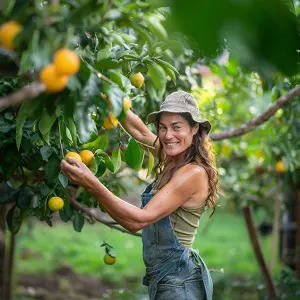
Emma Hudson
Forestry AuthorEmma's experience in farming shapes her detailed guides on gardening and farming tools, providing practical, actionable advice grounded in real-world experience. Her work targets both newcomers and experienced farmers, aiming to enhance their practices with a mix of traditional wisdom and modern techniques. By making complex agricultural concepts accessible, Emma's guides serve as valuable tools for those navigating the challenges of contemporary farming, offering strategies for sustainable success.












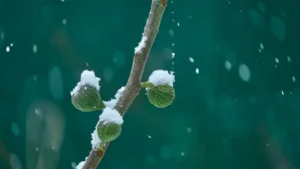
At what distance can Jacaranda trees be planted? Mine are at 4.8 Mt apart would like to plant in between. Thank you.
Eideard M"Cormaig-Beckett
June 17, 2024 4:29 am